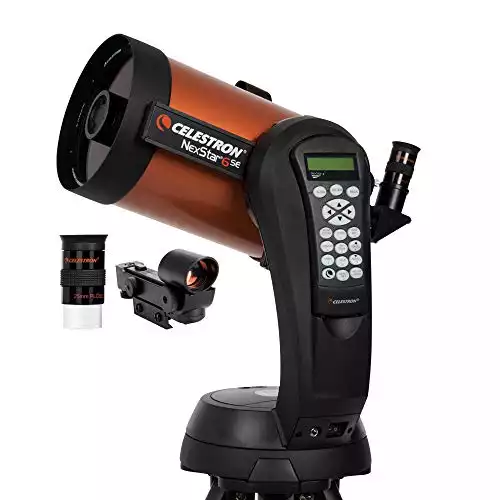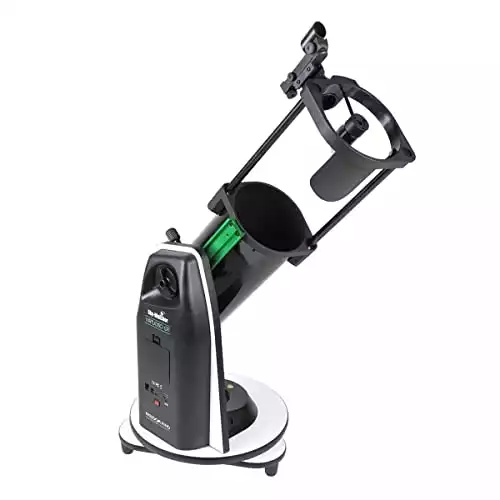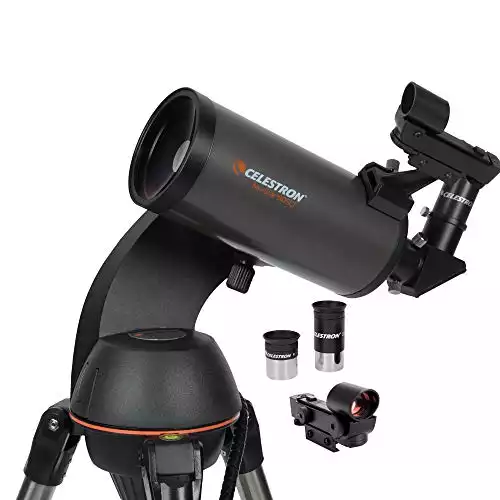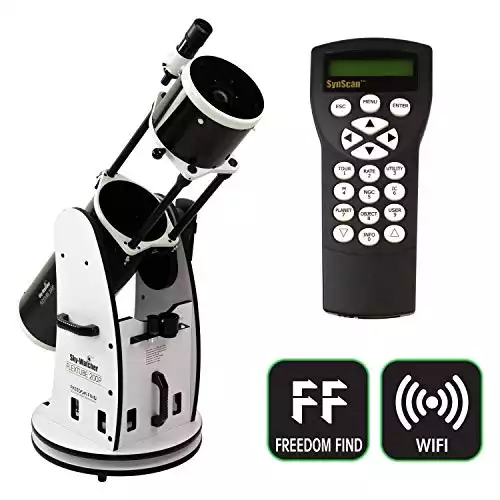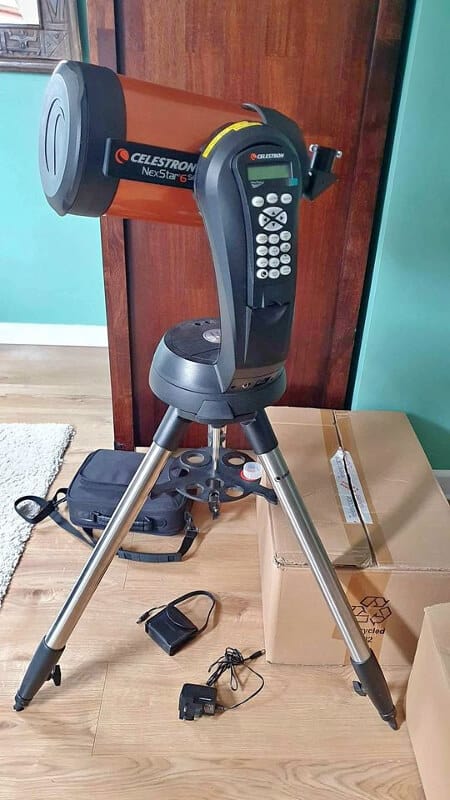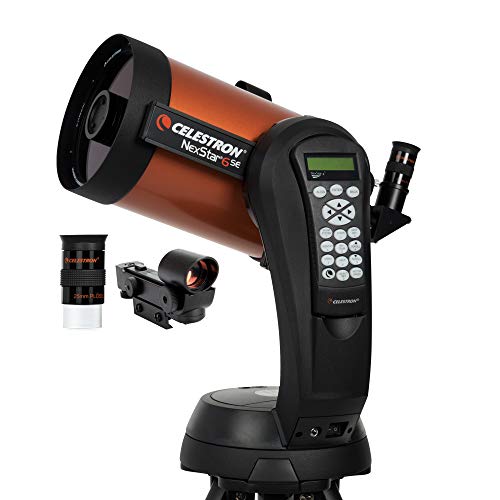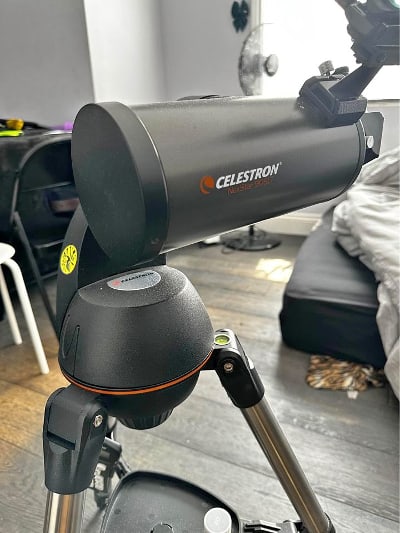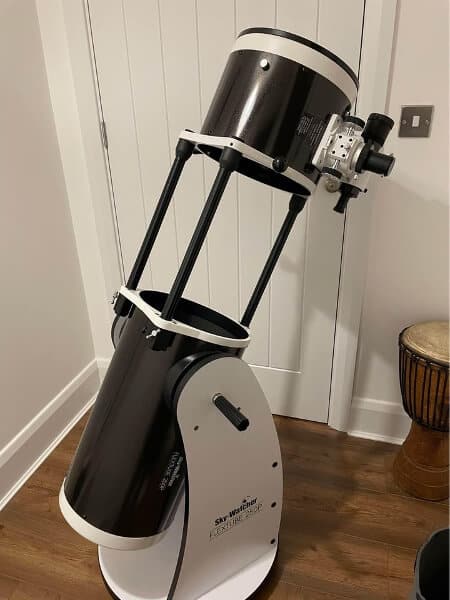With the Best Computerized Telescope, you can find stars, planets, galaxies, and more automatically at the press of a button.
Also known as GOTO telescopes, auto tracking telescopes, or computer-controlled telescopes, they are much easier to use and find amazing objects in space for you to view much quicker.
We have examined here the Best Telescopes With Auto Tracking, and we recommend three of the best models for you.
See the quick links in the table below or read on for more detail.
|
Make & Model:
Celestron Nexstar 6SE
|
Make & Model:
Sky-Watcher Virtuoso GTI 130P
|
Make & Model:
Celestron Nexstar 90SLT
|
Make & Model:
Sky-Watcher 8" Flextube SynScan 200P
|
|
Type:
Schmidt-Cassegrain
|
Type:
Tabletop Dobsonian
|
Type:
Maksutov-Cassegrain
|
Type:
Dobsonian
|
|
Aperture:
6-inch
|
Aperture:
5.1-inch
|
Aperture:
3.5-inch
|
Aperture:
8-inch
|
|
Weight:
30 lbs
|
Weight:
12 lbs
|
Weight:
23 lbs
|
Weight:
57 lbs
|
Best Computerized Telescopes
Celestron NexStar 6SE
Our Pick – Best Computerized Telescope
The Celestron NexStar 6SE is a great computerized telescope that works for beginners or intermediate users.
With this, you will be able to take advantage of GoTo technology to automatically locate planets, stars, and other objects at a press of a button from the database of 40,000 objects.
It is great for a beginner astronomer or just for someone keen to spend more time viewing and less time hunting those objects in space.
Like the model above, it is a compound telescope. Meaning it is compact, whilst offering great viewing capacity.
It has an aperture of 6-inches (that is the “6” in the name) and a focal length of 59 inches (1500 mm). In spite of it being very powerful, it also benefits from being smaller and easier to move and store.
It has an Alt-Azimuth mount, which is very easy to operate for observing the night sky and a separate piece of equipment (called an equatorial wedge) can be bought so that it can be used for astrophotography and taking photos of far off galaxies and other deep sky objects.
You can see it in action in this video here:
Pros
The reasons to want this telescope are:
- Computerized/GOTO Technology: This makes it a breeze to locate objects in space.
- Light and compact: Easy to store at home but also to pack up and take out in the field or on trips.
- Ease-of-use: Everything you need is in the package and requires to tools to set it up. So you can get going quickly and easily.
- Power: Cheap and great value for a computerized telescope.
- Astrophotography: It has a limited capacity to take photographs due to the type of mount and aperture size. You would be able to capture images of the moon and maybe some of the planets but not deep-sky objects.
Cons
Any downsides of this telescope are:
- Weight: At 30 lbs it’s pretty heavy and can be limiting in terms of being able to move around.
- Price: More expensive than the SLT range of Celestron telescopes covered above, but you definitely get better quality for what you pay for if you have the budget.
Key specifications
- Type: Schmidt-Cassegrain (Catadioptric) Computerized Telescope
- Mount: Alt-Azimuth
- Aperture: 6-inch (152 mm)
- Focal length: 1500 mm (59-inch)
- Focal ratio: F/10
- Assembled weight: 30 lbs (13.6 kg)
6-inch Aperture Schmidt-Cassegrain Telescope with GOTO Mount
- Large, 6-inch primary mirror packs enough light-gathering ability to deliver impressive views of the Moon and planets, along with deep-sky objects like the Orion Nebula, while retaining a compact form.
- A database of 40,000+ celestial objects, The GoTo mount locates and tracks objects for you. It's the perfect telescope for astronomy beginners.
- Assembling the telescope takes just a few minutes. When you're done observing, the telescope breaks down into small components for easy storage.
Other Celestron NexStar SE Computerized Telescopes
Also available are the same model telescope at different aperture specifications – check the prices for these telescopes at different retailers here:
- Celestron NexStar 4SE – 4-inch aperture
- Celestron NexStar 5SE – 5-inch aperture
- Celestron Nexstar 8SE – 8-inch aperture
The 4SE and 5SE are also great options for beginners in comparison to the SLT range covered above.
The 6SE and 8SE are better if you think you will venture into taking photos through your telescope (astrophotography) as they are compatible with the equatorial wedge for the mount that enables you to take long exposures.
Sky-Watcher Virtuoso GTI 130P
Best Budget Computerized Telescope
The Sky-Watcher Virtuoso GTi 130P is a compact tabletop Dobsonian telescope designed to provide an ultimate experience with convenience, flexibility, and light-gathering power.
It is perfect for beginners looking for their first telescope or experienced astronomers looking for a casual backyard or travel telescope.
The computerized ase includes built-in WiFi for complete remote control using the free Sky-Watcher SynScan app for iOS and Android. The app provides access to a database of over 10,000 objects, including the Messier, NGC, IC, and Caldwell catalogs. The patented Freedom Find technology uses dual encoders to allow manual control during the alignment process while retaining position.
The 130mm aperture, f/5 focal ratio and 650 mm focal length are perfect for viewing the Moon, planets, galaxies, and nebulae. The RAQ coatings ensure bright, bold views.
The package includes a red dot finder and 25 mm and 10 mm Super eyepieces, providing amateur astronomers with everything they need to start viewing right out of the box.
Using the Sky-Watcher Virtuoso GTi 130P was a delightful experience. The setup was straightforward, and the SynScan app made it easy to align and locate objects in the night sky. The GoTo technology and Freedom Find technology allowed for smooth and precise tracking of objects, even when manually adjusting the telescope.
The collapsible design of the OTA made it incredibly portable and easy to carry to different viewing locations. It delivered bright and bold views of the Moon, planets, and deep-sky objects.
Pros
- Compact and Portable: The collapsible design of the Optical Tube Assembly (OTA) makes it incredibly portable and easy to carry to different viewing locations.
- Built-in WiFi and GoTo Control: Allows for complete GoTo telescope control using a smartphone with the SynScan app, eliminating the need for a separate hand controller.
- High-Quality Optics: The 130 mm aperture OTA is equipped with Radiant Aluminum Quartz (RAQ) coatings for 94% reflectivity on all optical surfaces, ensuring bright and bold views of celestial objects.
- Freedom Find Technology: Uses dual encoders to allow manual control during the alignment process while retaining position, providing viewing flexibility.
- Included Accessories: Comes with a red dot finder and 25 mm and 10 mm Super eyepieces, providing everything needed to start viewing right out of the box.
Cons
- Dependent on Smartphone: Requires a smartphone with the SynScan app for GoTo control, which may not be preferred by some users who are used to traditional hand controllers.
- WiFi Connectivity: Built-in WiFi may sometimes experience connectivity issues, which can be frustrating during the alignment and viewing process.
- Battery Consumption: Using the smartphone for GoTo control and tracking can drain the phone’s battery quickly.
- Not Suitable for Advanced Astrophotography: While it is great for casual viewing and basic astrophotography, it may not meet the requirements of advanced astrophotographers.
Overall, this is a compact and portable telescope packed with features that make it an excellent choice for both beginners and experienced astronomers.
The built-in WiFi, GoTo technology, and Freedom Find technology make it easy to locate and track objects in the night sky. The high-quality optics deliver bright and bold views of celestial objects.
Key specifications
- Type: Reflector / Collapsible Tabletop Dobsonian
- Mount: Dobsonian
- Aperture: 5.1-inch (130mm)
- Focal Length: 650mm
- Focal Ratio: F/5
- Assembled Weight: 12 lbs
Collapsible Tabletop GoTo Dobsonian Telescope
- 5-inch aperture for extra power
- Fully GOTO Computerized base
- Convenient tabletop design
- Compact size and light weight
Celestron Nexstar 90 SLT
Best GOTO Telescope For Beginners
The Celestron Nexstar 90SLT is a compact computerized telescope that is perfect for those on a budget.
The “SLT” in the name stands for Star Locating Telescope which refers to the in-built GOTO technology that allows you to locate over 40,000 objects in space. The “90” in the name stands for the aperture in millimeters.
It is operated by a hand controller. With this you simply scroll through and select which sights are available to you in the night sky where you are located and the telescope moves to point at what you have selected.
You can see it (and others in the SLT range) in operation in this video from Celestron:
It is a Maksutov-Cassegrain (Catadioptric/Compound) telescope, if you’ve not heard those terms before don’t worry, all it means is that it is a small, light, compact – but quality – telescope.
It comes as a full package with the telescope, mount, tripod, and accessories including a finderscope and two eyepieces (25 mm and 9 mm).
Pros
The positives for this telescope are:
- Computerized/GOTO Technology: This makes it a breeze to locate objects in space.
- Light and compact: Easy to store at home but also to pack up and take out in the field or on trips.
- Ease-of-use: Everything you need is in the package and requires to tools to set it up. So you can get going quickly and easily.
- Price: Cheap and great value for a computerized telescope.
Cons
The downsides are:
- Viewing capacity: One downside is the slightly limited power of this telescope. The best measure of this is the 3.5-inch aperture and this is relatively small and may limit your capacity to clearly see certain objects in space – especially faint ones and/or if you are in a big town or city with light pollution. It this is an issue for you, you can consider some of the other telescopes in the SLT range outlined below or even those in the SE range (also outlined below).
- Astrophotography: It has a limited capacity to take photographs due to the type of mount and aperture size. You would be able to capture images of the moon and maybe some of the planets but not deep-sky objects.
- Power source: It can be run on AA batteries – which is great if you want to take it out on trips – However, it eats these up pretty quickly so you will probably want to buy the extra AC adapter or possibly an external power tank.
Overall, this is the perfect computerized telescope for beginners due to its ease of use. For this reason, it would also suit teenagers or even some younger children with supervision.
It is also perfect for those on a budget as it is probably the cheapest GOTO telescope available from a respected manufacturer.
Key specifications
- Type: Maksutov-Cassegrain (Catadioptric) Computerized Telescope
- Mount: Alt-Azimuth
- Aperture: 3.5-inch (90 mm)
- Focal length: 1250 mm (49-inch)
- Focal ratio: F/14
- Assembled weight: 12 lbs (5.4 kg)
Compact Computerized Telescope
- The Celestron NexStar 90SLT is a computerized telescope that offers a database of more than 40,000 stars, galaxies, nebulae, and more. The telescope locates your object with pinpoint accuracy and tracks it.
- This telescope for adults and kids to be used together is ideal for weekend camping trips or excursions to dark sky sites. Its compact form factor makes it easy to transport and assemble just about anywhere.
- The 90mm aperture gathers enough light to see our Solar System and beyond. View Saturn’s rings, Jupiter’s cloud bands, and the Moon in brilliant detail.
Other Celestron SLT Computerized Telescopes
Also available are the three other telescopes in the same Celestron SLT range. These are:
- Celestron Nexstar 102 SLT: This is a refractor telescope which means it is slightly more traditional looking with a longer tube. Slightly more viewing capacity than the model covered above.
- Celestron Nexstar 127 SLT: This is very similar to the 90 SLT above in that it is Maksutov-Cassegrain Telescope. Therefore it boasts the same positives but with more power. The downside is that it is heavier and will generally cost more, but you can check the live prices at different retailers by clicking the links here.
- Celestron Nexstar 130 SLT: This is the most powerful of the range but is a Reflector telescope which means that it is bigger, bulkier and heavier.
The number in the name refers to the aperture in millimeters, so you can see that these are all larger than the 90SLT above and so more powerful, but generally more expensive.
These are all great telescopes for beginners and in a similar price range. The 90, 102 and 127 are all pretty small and portable, but the 130 is bulkier – although the most powerful.
Sky-Watcher 8″ Flextube SynScan 200P
Power Pick – Best GOTO Telescope
The Sky-Watcher 8” SynScan Flextube Dobsonian is a revolutionary telescope that combines the best features of traditional Dobsonians with modern technology.
This telescope is big but incredibly portable for its size and can be assembled and ready to use in minutes.
The SynScan AZ hand control allows you to point your telescope at a specific object or tour the night sky at the touch of a button, with a database of over 42,900 objects. The patented dual encoder design allows the telescope to be moved manually without the need for re-alignment.
The telescope has 203 mm aperture, the focal length is 1200 mm, and the highest practical power is 406x.
The telescope has several slew speeds, tracking rates, and tracking modes, and the alignment method includes Brightest-Star Alignment and Two-Star Alignment. The Go-To Pointing Accuracy is up to 5 arc min, and the shipping weight is 39 kg in total (two boxes).
The Sky-Watcher Tension Control Handle (US Patent No. 6,940,642) is a unique feature that allows users to easily adjust the tension, thereby increasing or decreasing the friction between the optical tube and the sideboard of the mount. This eliminates the need for balancing the telescope and allows the optical tube to stay in position but can still be moved when prompted.
Pros
- Portability: The collapsible design of the telescope makes it incredibly portable and easy to transport.
- Ease of Use: The user-friendly menu system of the SynScan AZ hand control allows automatic slewing to over 42,900 objects after a simple two-star alignment procedure.
- Manual and Electronic Movement: The patented dual encoder design allows the telescope to be moved manually whenever the user wishes, without the need for re-alignment.
- Tension Control Handle: The innovative tension control handle allows easy adjustment of the friction between the optical tube and the sideboard of the mount, eliminating the need for balancing the telescope.
- Two Operation Modes: The telescope offers two different operation modes, Auto-Tracking Mode and AZ GOTO MODE, providing flexibility in how you observe the night sky.
- Extensive Object Database: The SynScan AZ hand control comes with a 42,900 object database, allowing you to explore a multitude of night sky treasures.
Cons
- Assembly Required: The telescope requires some assembly, especially the base, which is flat-packed.
- Power Supply: The telescope requires a power supply of 10 to 15 V DC 1Amp, which may not be readily available in some remote observing locations.
- Weight: The shipping weight of the telescope is 39 kg in total (two boxes), which may be considered heavy by some users.
- Cost: The advanced features and technology of the telescope make it relatively expensive compared to basic models.
Overall, this is great if you want the best computerized telescope and have:
- The budget for this premium model, and
- The space at home to store and use it.
Key specifications
- Type: Newtonian Reflector
- Mount: Dobsonian
- Aperture: 8-inch (203mm)
- Focal Length: 1200mm
- Focal Ratio: F/5.9
- Assembled Weight: 57 lbs
8-Inch Aperture GOTO Collapsible Dobsonian Telescope
- LARGE APERTURE: Get a bright, bold viewing experience at a fraction of the cost of other optical designs.
- INNOVATIVE COLLAPSIBLE DESIGN: Unique strut design allows for optical tube to collapse for ease of portability while keeping collimation.
- BUILT-IN WIFI: Control your telescope using a smartphone or tablet with Sky-Watcher’s proprietary built-in wifi signal.
- ALL METAL GEARING: Using all-metal gearing on a pair of DC servo motors, the SynScan Dobsonian combines the precise automated tracking of a computerized GoTo telescope with the bright large-aperture viewing of a Dobsonian.
Computerized vs Manual Telescopes
When we talk about computerized vs manual telescopes, what we are really talking about is the mount system that comes with the telescope.
Computerized telescopes have the technology built in to locate planets, galaxies, and other objects for you at the press of a button.
This contrasts with a manual telescope where you need to locate the objects manually by operating the mount by hand and attempting to find what you want to see by using a star map.
The telescope alone is sometimes referred to as an OTA (Optical Tube Assembly) and can always be used with either manual or GOTO mounts.
The mount is the equipment that sits between the tripod and the telescope (OTA) and allows it to move where it is pointing.
There are two main types of mount both of which can be computerized:
- Alt-Azimuth: Generally better for observing the night sky (astronomy) as they are very easy to operate with a handle so you can move it up and down, left and right.
- Equatorial: Better for taking photos (astrophotography) as they allow a full range of movement when tracking objects in space and are not restricted by up/down and left/right motions. They are harder to operate though and are also bulkier and heavier.
Computerized Telescope Advantages
- Ease-of-use: The one big advantage of GOTO telescopes – they are much quicker and easier to use when compared to a normal, manual telescope. If you are a beginner, a computerized telescope will allow you to locate many more objects much quicker than you could find on your own with a manual telescope. They are relatively simple to operate and you do not need to be an experienced astronomer.
- Location: They can also be a great option if you live in a city or under light-polluted skies. This is because if you are locating objects manually you will be using the stars as reference points and this is difficult when you can’t see many stars.
Computerized Telescope Disadvantages
- Price: The main disadvantage is the higher price. Computer-controlled telescopes do cost more than regular telescopes. If you have a set budget, buying a computerized option may mean you get a less powerful telescope, since the more powerful a telescope is the more expensive it will generally be, and so adding the GOTO element further increases the cost.
- Education: One other potential disadvantage is that learning how to use a manual telescope and locate objects in the sky yourself is one of the best ways to teach yourself astronomy. That being said, there is no reason that you cannot learn just as much with a computerized telescope, but it’ll be a little easier and so there are some obvious pros and cons to this.
- Power supply: Unlike manual telescopes, GOTO ones need to be plugged in or powered with batteries.
- Operability: Although finding objects is done for you with a GOTO telescope, taking a manual telescope out and operating it by hand is much simpler. Also something to consider is whether you are comfortable with electronics and computers. There can be software issues and some people might prefer manual options for this reason.
How to Choose a GoTo Telescope
Factors to consider when choosing a computer-controlled telescope are:
- Price: What’s your budget? They range from around $400-500 for the cheapest and into the thousands for more premium models.
- Size and weight: Consider your home and where you will use and store the telescope. Do you have space for a more powerful, but larger telescope?
- Type: You shouldn’t get too hung up on it but Catadioptric/Compound telescopes tend to be the smallest but most expensive in terms of price to aperture. Reflectors tend to be the bulkiest but the best value (Dobsonian telescopes are another type of reflector telescope that tend to be huge but provide high aperture). Refractors are usually in the middle.
- Specifications: You’ll see a lot of factors listed. Aperture is the most important as it is the best measure of a telescope’s viewing capacity. A higher focal length will make it better for viewing planets (see below). A higher focal ratio (as indicated by a lower F-number) indicates it will be better for astrophotography. As discussed above, Alt-Azimuth mounts are easier to use for viewing, Equatorial mounts are trickier and bulkier but better for photography.
Best Computerized Telescope FAQs
What’s the best computerized telescope for viewing the planets and moon?
For viewing the moon and planets of our solar system you would want to look at a telescope with a longer focal length.
For example, from the Celestron SLT range the 90SLT and 127SLT have much longer focal lengths than the other two models – see Celestron Nexstar: which model to buy? for a detailed breakdown.
A longer focal length indicates that it will zoom in more to a smaller field of view. This is perfect for viewing the moon and planets as they are relatively close to Earth in comparison to far-off galaxies, nebulae, and other deep space objects where higher aperture is the priority for good viewing.
What’s the most powerful computerized telescope?
Aperture is the best measure of power in a telescope and you can get computerized telescopes of 14-inch and 16-inch aperture from Celestron and Meade Instruments.
See The Most Powerful Telescopes You Can Buy for more information.
Are computerized telescopes good for children?
Yes, although probably only for children who are old enough to be able to take care of it.
See our article on the Best Telescopes for Kids for other options for different age ranges.
Verdict: What’s the Best Computerized Telescope?
Overall then, our recommendations are:
- Top Pick: Celestron NexStar 6SE – great if you want high power and the capacity to use it to take photos
- Budget Pick: Sky-Watcher Virtuoso GTI 130P – great value and convenient tabletop design
- Compact Pick: Celestron Nexstar 90SLT – affordable and great for beginners
- Power Pick: Sky-Watcher 8″ Flextube SynScan 200P – huge power and great views



